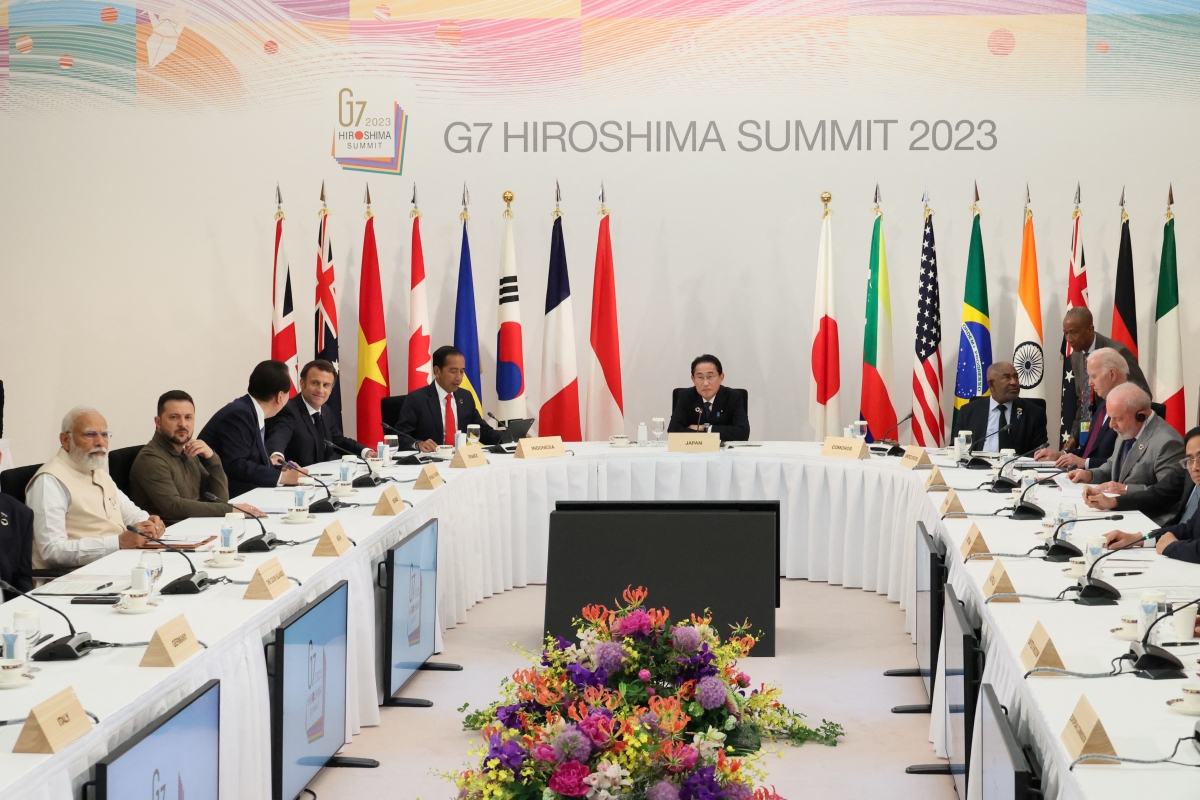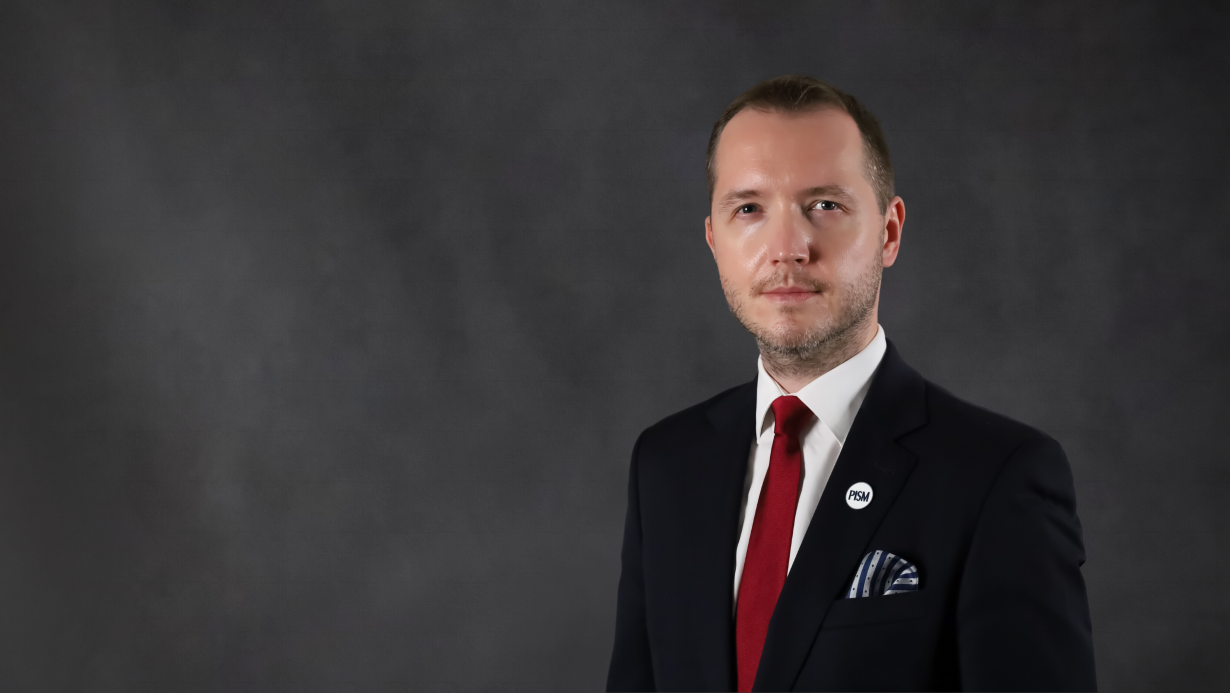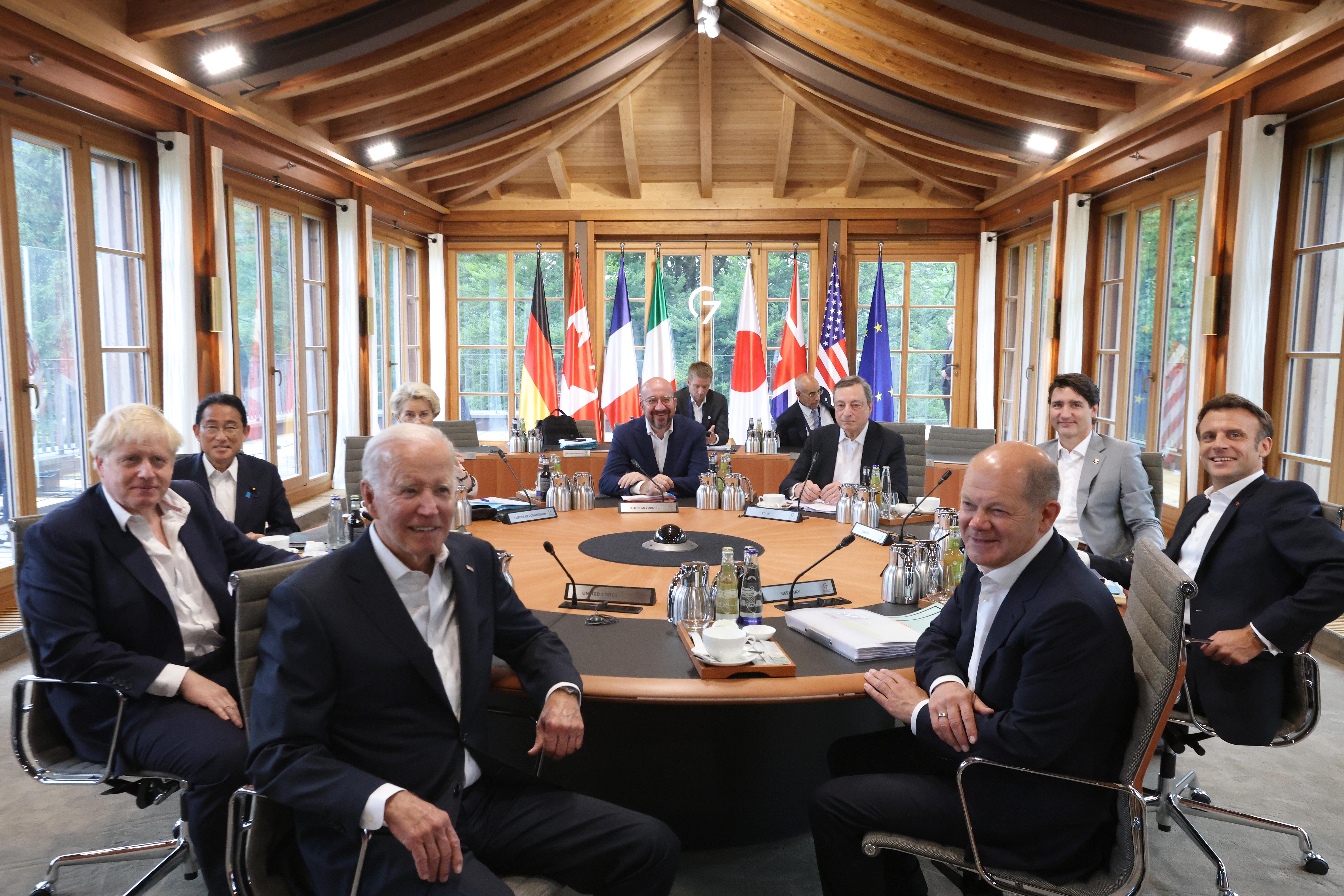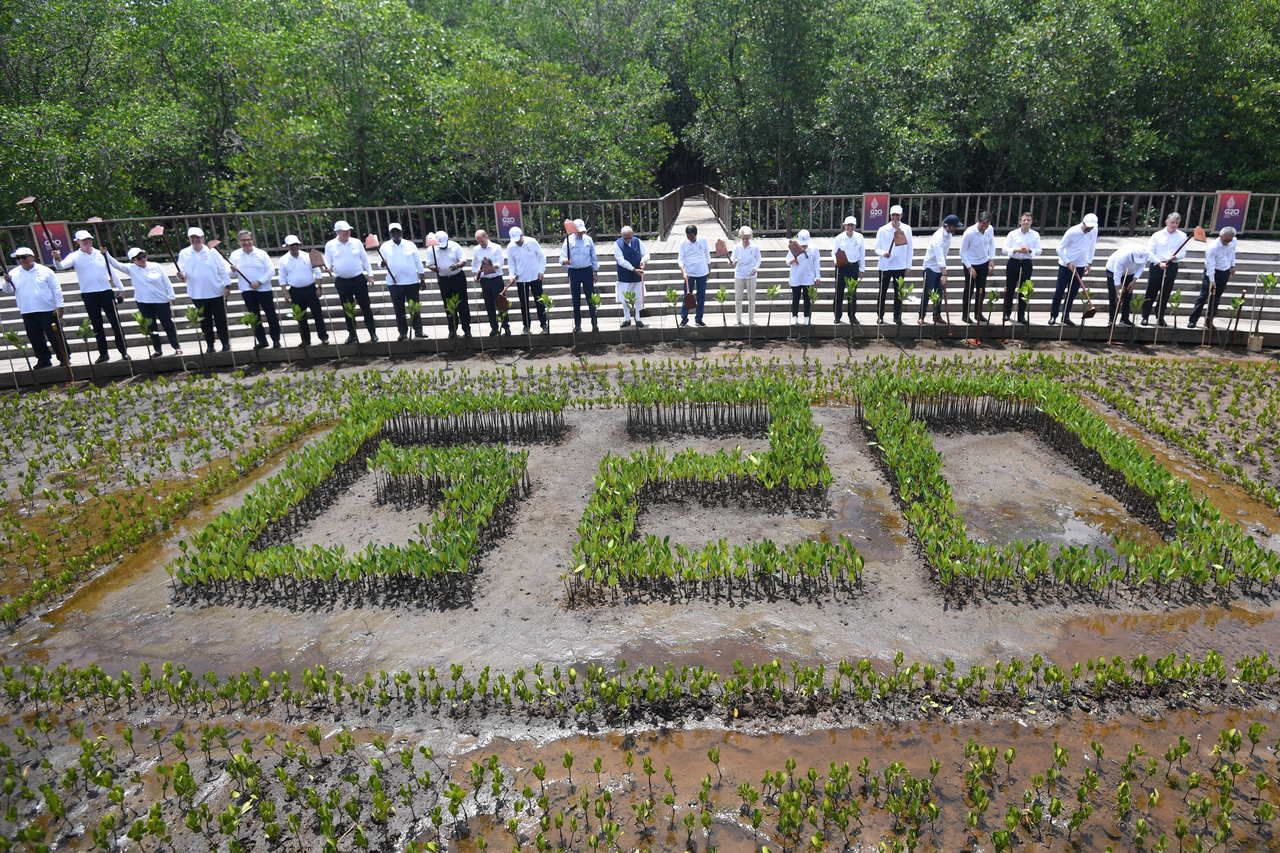Hiroshima Summit: G7 Again Backs Ukraine, Seeks to Reduce Dependency on China
At the summit in Japan on 19-21 May, G7 leaders, with President Volodymyr Zelensky attending in person, reaffirmed strong and long-term support for Ukraine in the fight against the Russian invasion. In addition, the Group wants to build stable relations with China while concurrently limiting interdependence, reduce nuclear arms, and regulate artificial intelligence. The G7 has presented unity regarding the main international issues and strives for cooperation with other countries concerning, for example, the war in Ukraine and strengthening global supply chains.
 HANDOUT / Reuters / Forum
HANDOUT / Reuters / Forum
The meeting took place shortly after Ukrainian President Volodymyr Zelensky completed his trip to several European countries (Italy, Germany, France, and the UK). On the eve of his arrival in Japan, the Ukrainian leader also attended the Arab League Summit. In this context, participation in the G7 meeting (comprising Canada, France, Germany, Italy, Japan, the UK, the U.S., and the EU) was the culmination of Zelensky’s diplomatic offensive aimed at gaining additional support in the war against Russia, including in the preparation of a Ukrainian counter-offensive. Before the summit, the U.S. announced its consent to the training of Ukrainian pilots in the operation of F-16 aircraft and the supply of these machines by a coalition of willing countries. The G7 meeting also took place in the context of China’s diplomatic activity, including a visit by its special envoy for Eurasian Affairs in Europe, including Ukraine. Importantly, the leaders of Australia, Brazil, Comoros, the Cook Islands, India, Indonesia, South Korea, and Vietnam were also invited to the summit. This demonstrated the growing involvement of the G7 in relations with partners with ambivalent positions on the war in Ukraine, those strongly affected by climate change, or which are strategically important in the context of the rivalry between the U.S. and China, especially Indo-Pacific countries.
Arrangements on the War in Ukraine
The decisions of the G7 members reinforce the actions they have taken so far. The leaders reiterated their assurances of financial, humanitarian, military, and diplomatic support for Ukraine for “as long as it takes”. They also underlined that any future peace agreement must consider the withdrawal of Russian troops from the occupied territories of Ukraine. This is a direct support for the peace conditions presented by Zelensky, and at the same time a response to China’s peace proposal, which does not include such a condition. The G7 is also to tighten sanctions imposed on Russia (including those concerning the industrial and technological sectors), cooperate with third countries to tighten restrictions, and coordinate actions against countries that support Russian aggression. Positive decisions include maintaining a price cap on Russian oil, which will further limit Russia’s income from trade in this raw material, and supporting third countries in becoming independent from Russia’s supplies of nuclear technologies, which may weaken Russia’s political influence. The leaders also announced post-war support for Ukraine’s reconstruction. For this purpose, the Ukraine Investment Platform was established in Tokyo on 12 May and is aimed to involve the private sector and others in this effort. The group also expressed its readiness to establish, together with other interested states and institutions, post-war commitments to ensure Ukraine’s security. Zelensky met on the sidelines of the summit with, among others, U.S. President Joe Biden, who announced a new military support package worth $375 million, as well as with the prime minister of India, Narendra Modi, and the president of Indonesia, Joko Widodo (a planned meeting with the president of Brazil, Luiz Inácio Lula da Silva, did not take place), which indicates a desire to convince regional powers to support Ukraine.
Relations with China
One of the main topics of the summit was the G7’s relations with China. The Group defined its approach in a pragmatic and realistic way. It announced that it wants to build “constructive and stable” relations with China, which should play an important role in the international arena as the world’s second-largest economy and an influential entity, for example, in the fight against climate change. However, the Group sees the threat of too high a degree of interdependence with China, mainly in the economic sphere, as it can be used as an instrument of pressure. Therefore, the G7 announced the aim of diversification of economic partners and reducing interdependence, thus limiting the risk (“de-risking”) of the use of links within supply chains for political purposes, but without cutting off entirely from China (“decoupling”). A platform is to be established to coordinate the activities of the G7 and its partners in preventing economic coercion stemming from China. The Group will also oppose China’s activities that disrupt the global economy, including the illegal transfer of technology. In this context, the G7 recognised the need to protect certain advanced technologies that could pose a threat to the security of its members (this could be done, for example, by export controls). The G7 called on China to put pressure on Russia to end its attack on Ukraine and withdraw troops from the occupied territories. It also reiterated its opposition to human rights violations in Tibet, Xinjiang, and Hong Kong, and advocated maintaining the status quo in the South China and East China seas, where China is asserting territorial claims, as well as in the Taiwan Strait.
Other Arrangements
One of the main issues raised by Japan during its presidency of the Group is the goal of reducing nuclear arms. This was underlined by the hosting of the summit in Hiroshima, which was the first city in history to experience a nuclear attack in August 1945. The group agreed to work to strengthen the non-proliferation regime as well as to strive for a world without nuclear weapons. Although these announcements do not mean a change in the nuclear policy of the U.S., France, or the UK, they are a signal of opposition to Russia’s threats to use this type of weapon against, for example, Ukraine, or North Korea’s nuclear tests, also highlighting the fact that China’s rapidly expanding arsenal is not covered by treaty restrictions.
The G7 also plans to diversify and strengthen supply chains with the participation of other partners, including developing countries, for example, in the field of trade in critical raw materials, which are crucial in such sectors as green energy (the scale of their processing in the G7 countries is also to be increased, which would reduce dependence in this area on China). The group also announced the intensification of talks on regulations and standards regarding the development of artificial intelligence as part of the “Hiroshima AI” process. The goal is to create inclusive technologies in line with the democratic values of the G7 members. At the same time, the leaders pointed out that the approaches and tools used may differ between countries, acknowledging the reality of competition within the group in the development of AI, which may be crucial for the competitiveness of economies in the future. The group also announced the transfer of $21 billion for humanitarian purposes, as well as actions to increase food and energy security, which is mainly a response to the needs of developing countries. It also confirmed its readiness to allocate $600 billion for the development of infrastructure in these countries, cooperation on climate change, the implementation of the Sustainable Development Goals, and support for preparations for future pandemics.
Conclusions and Perspectives
The Hiroshima Summit demonstrated the G7’s unity on key global issues and its commitment to restoring the rule-based international order by maintaining strong support for Ukraine to defend itself against Russian aggression. Although the leaders largely reiterated their previous commitments towards Ukraine, it is important in the context of the protracted conflict and emerging war fatigue in many Western countries. At the same time, the fact that much space is devoted to relations with China in the final communiqué indicates agreement within the group regarding their key nature in the long term. Recognising the need not only to reduce dependence on China but also to cooperate with it on global matters such as climate change may be a kind of expression of compromise between the more firm approach of the U.S., which seeks to reduce contacts with China in certain spheres, particularly in technology, and the more restrained position of EU countries that favour maintaining expanded trade relations with China. However, China considers the approach of the G7 presented at the summit to be “anti-Chinese”, which envision maintained tense relations. Thus, it is difficult to count on China’s more effective involvement in ending the war in Ukraine and limiting its support for Russia in the short term. The G7 also recognises the need for active action on global and technological issues, including the development of artificial intelligence. By inviting important partners from various parts of the world, the G7 is trying to gain the support, or at least friendly neutrality, of developing countries, which often have close relations with China or Russia. In conjunction with a real offer from the West in the economic, political, or security spheres for the diverse Global South, these contacts can be fruitful in the long term.






